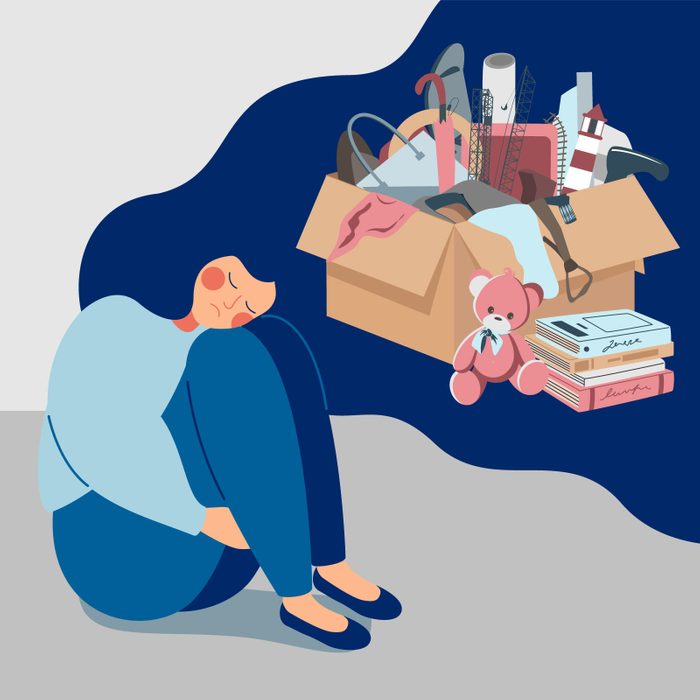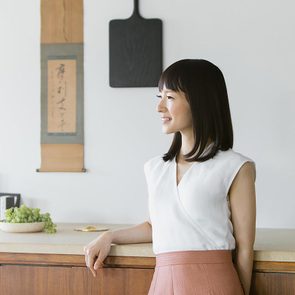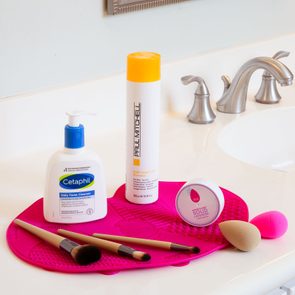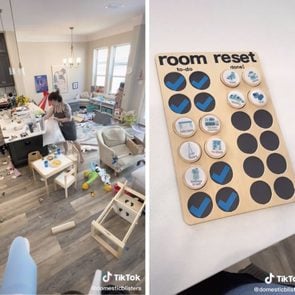How the KonMari Method Turned Me into a Clutterphobe and Sparked Anxiety
Updated: Apr. 10, 2023

Instead of sparking joy, the KonMari Method ratcheted up one woman's anxiety, but rethinking the role of cleaning in her life has made all the difference
I called it the Purge of the Century. A few years ago—after growing tired of having to physically and mentally prepare myself for the avalanche of stuff that would topple out anytime I opened a closet door—I finally decided to employ the KonMari Method, an approach to home organization made famous by tidying expert Marie Kondo that instructs followers to toss anything that isn’t “sparking joy.”
Like most people, I’d acquired a good deal of junk over the years. But my decade-plus career in the magazine industry had left me with a higher-than-average amount of promotional swag (hello, Top Chef rolling cooler cart) and personal care and beauty products. In the cabinet under my bathroom sink, a seemingly endless supply of shampoos and conditioners teetered on top of tubs of body cream. In my bedroom, baskets full of dusty nail polishes and lip glosses overflowed.
After reading Kondo’s bestselling book, The Life-Changing Magic of Tidying Up, I set out to clean house. I drew up a cleaning schedule, then loaded garbage bag after garbage bag with unnecessary clutter as I made my way through the categories laid out by Kondo: clothes, books, papers, kimono (miscellaneous items—i.e., all those aforementioned beauty freebies) and finally, sentimental items.
It felt great. My bathroom was clean and now expertly organized. The top of my dresser, once packed with lotions and perfume bottles and de-frizzing agents I rarely used, contained only a curated collection of my must-have products. I could fling open hallway closet doors without a care in the world.
Get Reader’s Digest’s Read Up newsletter for more cleaning, humor, travel, tech and fun facts all week long.
Decluttering remorse
The lessons from The Life-Changing Magic of Tidying Up stuck with me long after The Purge. But eventually, I began to feel that I’d veered too far to the other side. I scrutinized nearly everything in my apartment, agonizing over whether I really needed it.
Instead of sparking joy, Kondo’s seemingly benign cleaning tips were now sparking major anxiety.
I got rid of things quickly, sometimes rashly—then regretted it. Last spring, I donated a “mystery box” toy my then-4-year-old son had received. I hadn’t seen him play with it in a while, and it was big and didn’t fit in any of the bins in our organized toy area. When he discovered what I’d done, he was hysterical. This was not the first toy I’d gotten rid of (far from it), and I expected him to forget about it as he had with the others. But he asked about it every day for weeks. Guilt got the best of me, especially because he was going through a lot of transition at the time. So I promised to replace it.
Of course, I couldn’t find the toy anywhere. I finally tracked one down on eBay, where it was selling for $40, plus tax and shipping. My declutter panic button had cost me $65.33.
My anti-stuff behavior drove my ex crazy. I once discarded an errant cord without a second thought, only to find out he needed it to charge his PC. (Oops.)
And the tidying-up craze started to bother me too. In my quest to have less, I gave away stacks of books, keeping only my favorites—the ones that sparked joy without question. Months later, when I walked into a friend’s apartment and saw wall-to-wall bookshelves full of glorious literature, I felt a pang of sadness.
A less-extreme approach
Kondo herself recently admitted she’s loosened the reins on tidying up since the birth of her third child in 2021. “Up until now, I was a professional tidier, so I did my best to keep my home tidy at all times,” Kondo told the Washington Post while promoting her latest book, Marie Kondo’s Kurashi at Home. “I have kind of given up on that, in a good way for me. Now, I realize what is important to me is enjoying spending time with my children at home.”
Like Kondo, I’m embracing the mess more. (There is, however, one KonMari hack I will never have second thoughts about employing: her foolproof formula for folding clothes.)
These days, I try to find the happy medium between minimalism and hoarding by:
- Setting things aside first. The last time I sifted through my son’s toys, I hid them away for a few weeks before donating them to make sure he didn’t desperately miss anything. (He didn’t.)
- Adopting an attitude of gratitude for things I need in everyday life. (Talk about truly sparking joy!)
- Doing micro purges. If I think in terms of having to declutter my entire space, I get overwhelmed and feel inclined to throw out more. When I do smaller clean-outs—one kitchen drawer, for example—I’m more generous about what can stay.
As with most things, it’s about balance. I like having a mostly tidy, organized home. But I don’t want to be constantly worried that I have too much stuff. Eventually, my son will outgrow the Lego bricks and the trucks and the puzzles that spill out into the living room. When I look back, I’ll be happy I spent less time sorting through his toys and more time enjoying the moment.
Source:
- Washington Post: “Marie Kondo’s life is messier now—and she’s fine with it”



